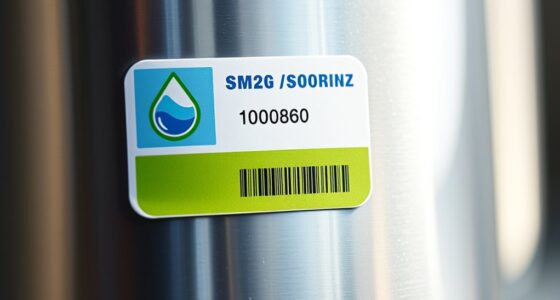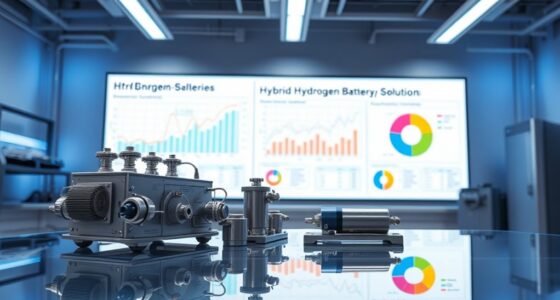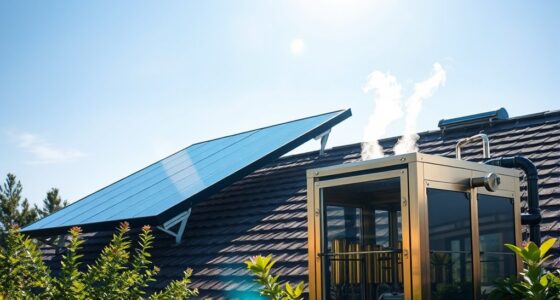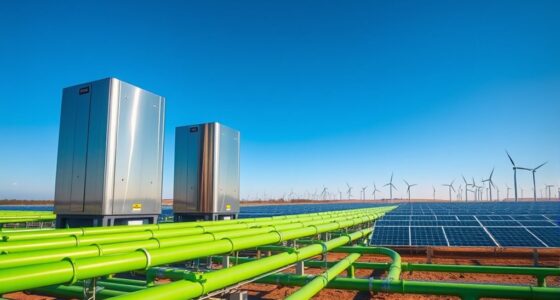As a Vermont tiny house dweller, I encountered the obstacle of figuring out a sustainable solution for disposing of my greywater.
After researching various options, I discovered innovative solutions that not only protect the environment but also serve the needs of others.
In this article, I will share practical techniques for recycling greywater, utilizing it for irrigation, and constructing a greywater garden.
Join me as we explore the possibilities of responsibly managing greywater in our tiny homes.

Key Takeaways
- Greywater recycling systems can be used to filter and reuse greywater in a tiny house in Vermont, reducing water waste.
- Composting toilets are a sustainable option for disposing of greywater in a tiny house, as they turn waste into nutrient-rich compost.
- Constructing a greywater garden with proper filtration and drainage systems can help effectively utilize greywater for irrigation in a tiny house.
- There are various treatment options available for greywater disposal in tiny houses in Vermont, including constructed wetlands, sand filters, UV disinfection systems, and membrane bioreactors. The choice of treatment method should consider compliance with legal regulations and specific needs.
Greywater Recycling Systems
I often use greywater recycling systems in my tiny house in Vermont to reduce water waste and promote sustainability. Greywater filtration techniques and reuse strategies are essential components of these systems.
The greywater from my sinks, showers, and laundry is collected and treated before being reused for non-potable purposes. This process involves several steps.
First, the greywater is directed to a collection tank where larger debris is filtered out. Then, it goes through a series of filters to remove smaller particles and contaminants. Finally, the treated greywater is stored in a separate tank and used for activities like toilet flushing and irrigation.
Composting Toilets for Greywater Disposal
One option for disposing of greywater in a tiny house in Vermont is through the use of composting toilets. Composting toilets offer several benefits for the environmentally conscious individual.

Firstly, they help conserve water by eliminating the need for flushing, reducing overall water consumption.
Secondly, they promote sustainability by turning waste into nutrient-rich compost that can be used in gardening or landscaping.
Installing a composting toilet involves a few key steps. Firstly, you need to choose the right type of composting toilet for your tiny house, considering factors such as size, ventilation, and odor control.
Next, you need to install the toilet according to the manufacturer’s instructions, ensuring proper ventilation and waste separation.

Finally, you need to maintain and manage the composting toilet, regularly adding bulking material and monitoring the composting process.
Constructing a Greywater Garden
Constructing a greywater garden involves selecting suitable plants, creating a drainage system, and ensuring proper filtration. To serve others in creating a functional and sustainable greywater garden, I’ll provide technical details on the process. Here are four key aspects to consider:
-
Rainwater harvesting techniques: Utilizing rainwater for irrigation reduces water consumption and promotes self-sufficiency. Implementing rain barrels or a rainwater collection system can capture and store water for later use.
-
Benefits of using natural filtration systems in greywater gardens: Natural filtration systems, such as wetlands or constructed wetlands, can effectively treat greywater. These systems utilize plants, soil, and microbes to remove contaminants and improve water quality, benefiting both the environment and the community.

-
Plant selection: Choosing plants that thrive in moist conditions and can tolerate greywater is essential. Native species like rushes, sedges, and ferns are often recommended for their ability to absorb nutrients and filter water effectively.
-
Proper drainage and filtration: To ensure efficient greywater treatment, proper drainage and filtration systems should be implemented. This may include using gravel-filled trenches, mulch basins, or biofilters, which allow for the gradual percolation of water while removing impurities.
Utilizing Greywater for Irrigation
To maximize water conservation and support sustainable gardening practices, it’s important to utilize greywater for irrigation and implement efficient systems for its distribution. One effective method is rainwater harvesting for irrigation. By capturing and storing rainwater, you can supplement or even replace the use of potable water for watering your plants.
Another approach is to incorporate permaculture techniques for greywater utilization. Permaculture focuses on designing sustainable systems that work in harmony with nature. By using greywater in a permaculture garden, you can create a closed-loop system where the water is recycled and reused to nourish your plants.

These techniques not only conserve water but also minimize the strain on local water resources.
Now, let’s delve into the next section to explore greywater treatment options for tiny houses in Vermont.
Greywater Treatment Options for Tiny Houses in Vermont
I will explore different greywater treatment options for my tiny house in Vermont, and determine the most suitable method for my specific needs. When it comes to greywater filtration methods, there are several options available that comply with legal regulations. Here are four options to consider:
-
Constructed Wetlands: Creating a wetland system involves using plants and natural filtration processes to treat greywater before it’s discharged. This option is environmentally friendly and can provide a visually appealing feature to your property.

-
Sand Filters: Sand filters are an effective method for removing impurities from greywater. The water passes through layers of sand, gravel, and sometimes activated charcoal, which helps to remove contaminants and improve water quality.
-
Biological Filters: These filters use living organisms, such as bacteria and fungi, to break down and remove pollutants from the greywater. They’re low maintenance and can be a cost-effective option for treating greywater.
-
Membrane Bioreactors: Membrane bioreactors use a combination of biological and physical filtration processes. The greywater is treated by a combination of biological decomposition and filtration through a membrane, resulting in high-quality water suitable for reuse.
Considering these greywater treatment options and their compliance with legal regulations, I can choose the method that best suits my tiny house and serves the environment and community.

Frequently Asked Questions
How Much Water Can Be Saved by Implementing a Greywater Recycling System in a Tiny House in Vermont?
Implementing a greywater recycling system in my tiny house in Vermont can save a significant amount of water. This sustainable living practice promotes water conservation and contributes to a more environmentally friendly lifestyle.
Are There Any Regulations or Permits Required for Installing a Composting Toilet for Greywater Disposal in Vermont?
There are regulations and permits required for installing a composting toilet for greywater disposal in Vermont. It is important to comply with these guidelines to ensure proper waste management and environmental protection.
What Are Some Alternative Methods for Constructing a Greywater Garden in a Tiny House?
I can share some alternative construction methods for creating a greywater garden in a tiny house. DIY greywater systems, such as mulch basins and constructed wetlands, can be effective and environmentally friendly options.
Can Greywater Be Used for Purposes Other Than Irrigation in a Tiny House in Vermont?
Greywater can be used for household cleaning in a tiny house, but it’s important to consider the potential health risks associated with its reuse. Proper filtration systems and disinfection methods should be implemented.

Are There Any Eco-Friendly Greywater Treatment Options Available Specifically for Tiny Houses in Vermont?
There are eco-friendly greywater treatment options available for tiny houses in Vermont that comply with regulations. These options can effectively treat greywater and make it safe for reuse or disposal, ensuring sustainability and environmental responsibility.
Conclusion
In conclusion, when it comes to disposing of greywater in a tiny house in Vermont, there are several options available. One can consider installing a greywater recycling system. This system allows for the treatment and reuse of greywater within the house, reducing water consumption and environmental impact.
Another option is using a composting toilet for greywater disposal. Composting toilets break down waste and convert it into compost, which can be used as fertilizer for plants. This method allows for a more sustainable and eco-friendly approach to greywater disposal.
Constructing a greywater garden is also a viable option. This involves creating a designated area in the garden where greywater can be directed. The plants in the garden then filter and absorb the nutrients from the greywater, effectively treating it and reducing the amount of wastewater that needs to be disposed of elsewhere.

Lastly, utilizing greywater for irrigation is another practical solution. This involves redirecting greywater from sinks, showers, and other sources to water outdoor plants and gardens. Greywater can provide a valuable source of irrigation water, reducing the need for fresh water and conserving water resources.
It’s important to carefully consider the best option that suits your needs and adhere to local regulations. Each method has its own advantages and considerations, so it’s crucial to research and plan accordingly. Remember, as the saying goes, "Waste not, want not."
I’m Theodore, and I love tiny houses. In fact, I’m the author of Tiny House 43, a book about tiny houses that are also tree houses. I think they’re magical places where imaginations can run wild and adventures are just waiting to happen.
While tree houses are often associated with childhood, they can be the perfect adult retreat. They offer a cozy space to relax and unwind, surrounded by nature. And since they’re typically built on stilts or raised platforms, they offer stunning views that traditional homes simply can’t match.
If you’re looking for a unique and romantic getaway, a tree house tiny house might just be the perfect option.
















